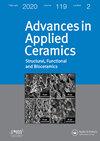采用溶胶-凝胶涂层强化自上光氧化锆与釉质的结合
IF 1.6
4区 材料科学
Q3 MATERIALS SCIENCE, CERAMICS
引用次数: 0
摘要
摘要采用溶胶-凝胶涂层技术对自上光氧化锆(SZ)的粘结表面进行修饰。将其与传统的气相颗粒研磨氧化锆(CZa)和热压二硅酸锂(LDe)玻璃陶瓷进行对比,考察其对釉质结合强度的影响。所有的陶瓷样品都用胶粘剂树脂粘接在蚀刻好的牛牙釉质上。不同策略的溶胶-凝胶包覆SZ基团(SZc1和SZc2)的剪切强度分别为20.00±7.07 MPa和18.32±3.63 MPa,与LDe的剪切强度(18.44±2.27 MPa)相当(p > 0.05),显著高于CZa的剪切强度(11.72±1.48 MPa)和SZ的剪切强度(3.06±1.66 MPa) (p < 0.05)。SZc1的键合表面存在大量氧化锆团簇之间的空隙,而SZc2的键合表面则呈现均匀的蜂窝状纳米孔结构。除SZ外,其余各组均表现为混合性破坏,SZc1、SZc2和LDe的断裂面润湿性优于CZa。溶胶-凝胶包覆可以提高SZ与牙釉质的结合强度,具有微创修复的潜力。本文章由计算机程序翻译,如有差异,请以英文原文为准。
Strengthen the bonding of self-glazed zirconia to enamel by sol–gel coating
ABSTRACT Sol–gel coating technology was applied to modify the bonding surface of self-glazed zirconia (SZ). Its effect on the bond strength of SZ to enamel was evaluated in vitro in comparison with the conventional milled zirconia treated by airborne-particle abrasion (CZa) and the heat-pressed lithium disilicate glass-ceramics treated by etching and silanization (LDe). All ceramic specimens were bonded to the etched bovine enamel with adhesive resin cement. Shear bond strength of both sol–gel coated SZ groups with different strategies (SZc1 and SZc2) was 20.00 ± 7.07 MPa and 18.32 ± 3.63 MPa, respectively, which was comparable to that of LDe, 18.44 ± 2.27 MPa (p > 0.05) and significantly higher than that of CZa, 11.72 ± 1.48 MPa, and SZ, 3.06 ± 1.66 MPa (p < 0.05). Lots of voids between zirconia clusters were observed on the bonding surface of SZc1, yet that of SZc2 showed homogeneous honeycomb nanoporous structure. All groups exhibited mixed failure except SZ, and the fracture surfaces of SZc1, SZc2, and LDe showed better wettability than CZa. Sol–gel coating could improve the bond strength of SZ to enamel, and the sol–gel coated SZ might have the potential to make minimally invasive restorations.
求助全文
通过发布文献求助,成功后即可免费获取论文全文。
去求助
来源期刊

Advances in Applied Ceramics
工程技术-材料科学:硅酸盐
CiteScore
4.40
自引率
4.50%
发文量
17
审稿时长
5.2 months
期刊介绍:
Advances in Applied Ceramics: Structural, Functional and Bioceramics provides international coverage of high-quality research on functional ceramics, engineering ceramics and bioceramics.
 求助内容:
求助内容: 应助结果提醒方式:
应助结果提醒方式:


